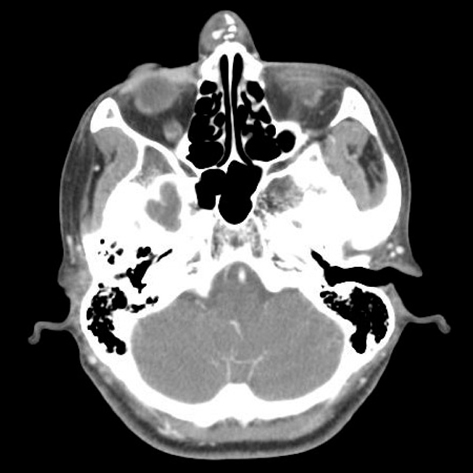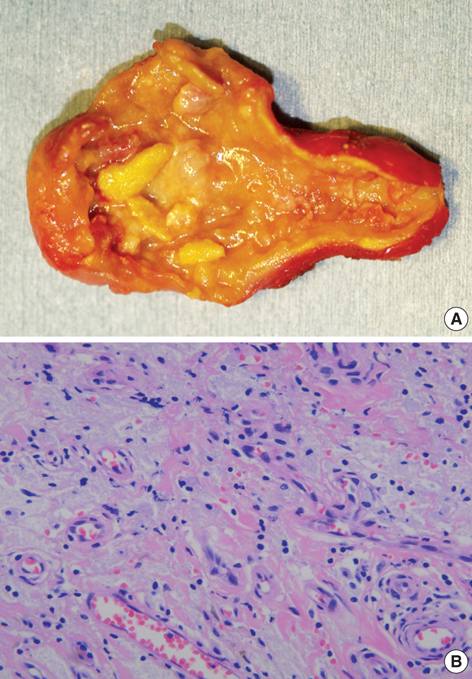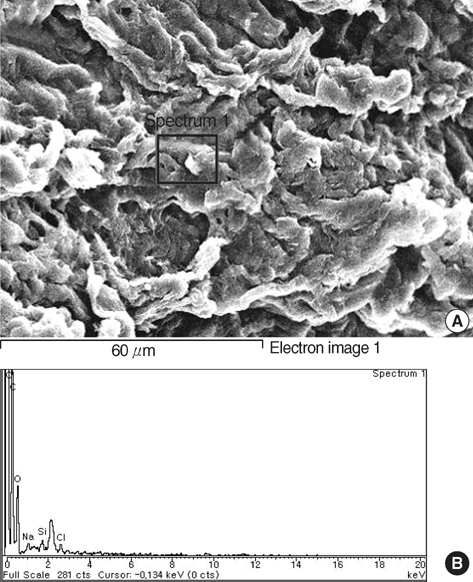J Korean Med Sci.
2008 Dec;23(6):1109-1112. 10.3346/jkms.2008.23.6.1109.
Foreign Body Inclusion Cyst of the Nasal Radix after Augmentation Rhinoplasty
- Affiliations
-
- 1Department of Otorhinolaryngology, Head and Neck Surgery, Seoul National University Boramae Hospital, Seoul, Korea. hrjin@paran.com
- KMID: 1107541
- DOI: http://doi.org/10.3346/jkms.2008.23.6.1109
Abstract
- Development of a cystic mass on the nasal dorsum is a very rare complication of aesthetic rhinoplasty. Most reported cases are of mucous cyst and entrapment of the nasal mucosa in the subcutaneous space due to traumatic surgical technique has been suggested as a presumptive pathogenesis. Here, we report a case of dorsal nasal cyst that had a different pathogenesis for cyst formation. A 58-yr-old woman developed a large cystic mass on the nasal radix 30 yr after augmentation rhinoplasty with silicone material. The mass was removed via a direct open approach and the pathology findings revealed a foreign body inclusion cyst associated with silicone. Successful nasal reconstruction was performed with autologous cartilages. Discussion and a brief review of the literature will be focused on the pathophysiology of and treatment options for a postrhinoplasty dorsal cyst.
Keyword
MeSH Terms
Figure
Reference
-
1. Pak MW, Chan ES, van Hasselt CA. Late complications of nasal augmentation using silicone implants. J Laryngol Otol. 1998. 112:1074–1077.
Article2. Harley EH, Erdman JP. Dorsal nasal cyst formation. A rare complication of cosmetic rhinoplasty. Arch Otolaryngol Head Neck Surg. 1990. 116:105–106.
Article3. White MI, Smart LM, Macgregor DM, Rayner CR, Smith FW. Recurrent facial oedema associated with a silicone-rubber implant. Br J Dermatol. 1991. 125:183–185.
Article4. Kotzur A, Gubisch W. Mucous cyst--a postrhinoplasty complication: outcome and prevention. Plast Reconstr Surg. 1997. 100:520–524.
Article5. Lawson W, Kessler S, Biller HF. Unusual and fatal complications of rhinoplasty. Arch Otolaryngol. 1983. 109:164–169.
Article6. Shulman Y, Westreich M. Postrhinoplasty mucous cyst of the nose. Plast Reconstr Surg. 1983. 71:421–422.
Article7. Kossovsky N, Freiman CJ. Silicone breast implant pathology. Clinical data and immunologic consequences. Arch Pathol Lab Med. 1994. 118:686–693.8. Tang L, Lucas AH, Eaton JW. Inflammatory responses to implanted polymeric biomaterials: role of surface-adsorbed immunoglobulin G. J Lab Clin Med. 1993. 122:292–300.9. Tham C, Lai YL, Weng CJ, Chen YR. Silicone augmentation rhinoplasty in an Oriental population. Ann Plast Surg. 2005. 54:1–7.
Article10. Wang TD. Non-Caucasian rhinoplasty. Facial Plast Surg. 2003. 19:247–256.
Article11. Yang J, Wang X, Zeng Y, Wu W. Biomechanics in augmentation rhinoplasty. J Med Eng Technol. 2005. 29:14–17.
Article12. Narins RS, Beer K. Liquid injectable silicone: a review of its history, immunology, technical considerations, complications, and potential. Plast Reconstr Surg. 2006. 118:3 Suppl. 77S–84S.
Article13. Fulton JE Jr, Porumb S, Caruso JC, Shitabata PK. Lip augmentation with liquid silicone. Dermatol Surg. 2005. 31:1577–1586.
Article
- Full Text Links
- Actions
-
Cited
- CITED
-
- Close
- Share
- Similar articles
-
- Correction of Hump Nose Considering the Characteristics of Korean Nose
- Radix augmentation using temporalis fascia graft
- A Case of Dorsal Nasal Cyst after Augmentation Rhinoplasty
- Nasal tip surgery: nasal lengthening and augmentation in Asian rhinoplasty
- Epidermal Cyst of the Nasal Tip Presenting as Foreign Body Reaction





